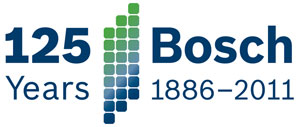A young German engineer, Robert Bosch, founded an engineering company 125 years ago that then and today enjoys pivotal significance in the automotive industry and the aftermarket. Established in Stuttgart in 1886, as the “Workshop for Precision Mechanics and Electrical Engineering,” Robert Bosch Gmbh in 2011 is celebrating its 125th anniversary, as well as the 150th anniversary of its founder’s birth. 2011 is also the 75th anniversary of Bosch’s introduction of automotive diesel systems.

Over the past 125 years, Robert Bosch has seen steady, exponential growth to become the world’s largest automotive supplier, with worldwide influence and the reputation as a technology leader and innovator.
Bosch began its journey to worldwide leadership in 1902 when the company developed the first commercially viable high-voltage spark plug and transformed the rudimentary automobiles of the day into reliable vehicles. In the century and a quarter since it was founded, Bosch has unfolded a steady stream of automotive technological breakthroughs, expanded into sophisticated automotive diagnostics and wheel service products, and built a worldwide reputation for product engineering, quality and reliability.
Highlights of the company’s steady growth and automotive leadership include products and systems that have been and remain very important to the aftermarket, including:
• 1902: Bosch is granted a patent for a new type of spark plug combined with a high-tension magneto on January 7, 1902. The first systems are supplied to Daimler-Motorengesellschaft.
• 1906: Begins automotive product operations in the United States.
• 1911: Bosch spark plugs power Marmon Wasp to win first Indy 500.
• 1913: Introduces Bosch lighting system, begins manufacturing automotive generators.
• 1921: Establishes worldwide Bosch Service Centers.
• 1927: Develops first electric windshield wiper system.
• 1927: Bosch introduces the term “heat range” which has remained the standard measure of the thermal capacity of a spark plug to this day.
• 1936: Bosch introduces diesel systems for automobiles.
• 1953: Spark plug with compound center electrode ensuring reliable cold starting and a longer service life is used on the Mercedes Benz 300 SL gull-wing.
• 1967: Bosch Jetronic electronic fuel injection system introduced.
• 1968: Bamberg spark plug plant produces the billionth spark plug.
• 1976: Automotive oxygen sensors introduced.
• 1976: Mass production of the Thermoelastic plug with compound center electrode begins.
• 1978: ABS braking system introduced.
• 1980s: Copper core spark plugs introduced to adapt to changes in fuels and engine design.
• 1983: Platinum center electrodes and composite materials with noble metal alloys boost the service life of spark plugs introduced.
• 1991: Bosch spark plug with surface/air gap prevents carbon fouling, timing drift and misfiring even in operation with frequent short trips.
• 1995: ESC stability control systems introduced.
• 1995: Nickel yttrium electrode material introduced, prolongs the service life of spark plugs.
• 2000: The seven billionth Bosch spark plug is produced.
• 2000: Supplied tailor-made spark plugs for the first direct injection stratified charge gasoline engine (with ignition and injection system also supplied by Bosch).
• 2002: 100th anniversary of the first Bosch spark plug.
• 2003: Acquired Vetronix, began expanding Bosch Diagnostics in the U.S.
• 2006: Platinum Ir Fusion platinum/iridium spark plug introduced.
• 2008: Entered solar cell market.
• 2009: Developed parallel hybrid and electric vehicle programs.
• 2010: New, ultra modern semiconductor facility opened.
The Bosch Group comprises Robert Bosch GmbH and its more than 350 subsidiaries and regional companies in over 60 countries. If its sales and service partners are included, then Bosch is represented in roughly 150 countries.

“Invented for Life”
With 3,800 patent applications filed each year and nearly $5 billion invested annually in research and development, Bosch aims to maintain its focus on innovation in the future, and in this way to lay the foundations for further sustainable growth. In accordance with its strategic guiding principle, the products supplied by the three Bosch business sectors Automotive Technology, Industrial technology, and Consumer Goods and Building Technology are technology that is “invented for life.”
Bosch has become one of the world’s leading manufacturers of diesel and gasoline injection systems and vehicle safety systems such as the ABS antilock braking system and the ESP (ESC) electronic stability program. Bosch is also one of the largest suppliers of power tools, heating technology, household appliances, and security systems. The Bosch Industrial Technology business sector is a recognized specialist in drive and control technologies. The business sector also includes the Packaging Technology and Solar Energy divisions.
With long-term considerations in mind, Bosch is investing in promising markets such as renewable energy and electromobility. Accordingly, some 50 percent of the annual research and development budget is devoted exclusively to products that conserve energy and resources. At the same time, the company has for decades now been developing innovations whose everyday use saves considerable amounts of energy worldwide – in automotive powertrains, in household appliances, and in heating, cooling, and air conditioning.
Bosch in North America
Bosch in North America supplies automotive original equipment and aftermarket products, industrial drives and control technology, power tools, security and packaging technology, thermotechnology, household appliances, solar energy, healthcare and software innovations. Having established its regional presence in 1906, Bosch now employs more than 22,000 associates in roughly 100 locations throughout North America.
Bosch is a proud supporter of the Automotive Aftermarket Suppliers Association’s Know Your Parts education and awareness campaign. This initiative promotes the importance of quality brand name aftermarket parts backed by full service suppliers, and its impact on delivering reliable products to today’s motorists. For more information visit: www.AASAKnowYourParts.org.
For more information, visit www.boschusa.com.
For more information on Bosch Automotive Products, visit www.boschautoparts.com.
Find Bosch Auto Parts on Facebook, visit www.facebook.com/boschautoparts.
Follow Bosch Auto Parts on Twitter, visit www.twitter.com/BoschAutoParts.









